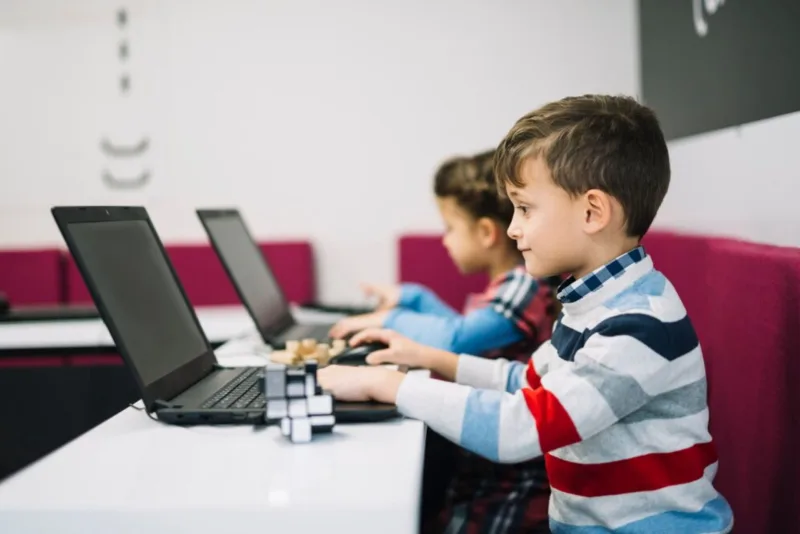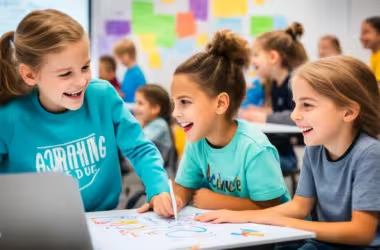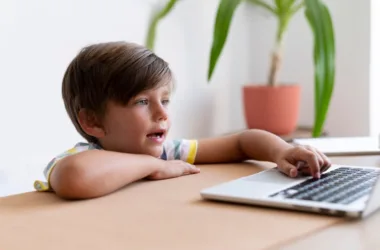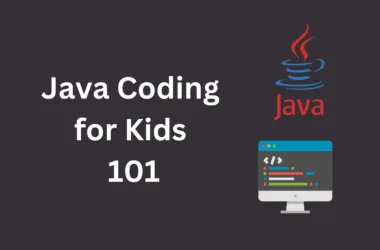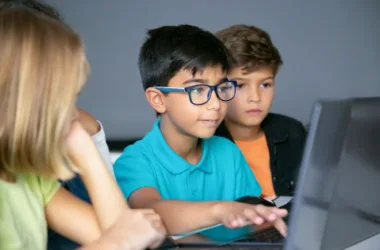There’s a saying that there are a million ways to do something right? Yeah, but it is not the same case when kids are learning how to code, why because there are often important stuff that can’t be missed.
Coding has building blocks that are fundamentals every learner including kids must follow in order to be good at it, or else will just be another half-baked programmer.
In this blog post, we’ll go through the best possible ways to introduce coding to your kids without making them lose interest or bored with it.
Start with Age-Appropriate Platforms
Not all coding platforms are created equal! When it comes to young learners, engaging interfaces and playful introductions to coding concepts are key. Here are some of our recommended options categorized by age group;
Youngest Coders (Ages 5-7)
- ScratchJr: This colorful drag-and-drop platform lets little ones create interactive animations by snapping together colorful blocks. It’s a fantastic introduction to basic coding concepts like sequencing and loops in a fun and visually appealing way.
- Kodable: This award-winning platform takes your child on an adventure through whimsical coding quests. Through playful activities and puzzles, they’ll learn essential coding skills like problem-solving, logic, and understanding algorithms.
For Budding Coders (Ages 8-12)
- Scratch: This popular platform by MIT is a stepping stone to more complex coding languages. Kids can create interactive stories, animations, and even games by using colorful blocks that represent coding commands.
- Tynker: This gamified platform uses block-based coding along with popular characters and storylines to keep kids engaged. They can progress through levels, building games, and animations, and even code their own Minecraft mods.
For Aspiring Programmers (Ages 13+)
- Blockly: This powerful platform by Google allows kids to experiment with various programming languages like Python and JavaScript. It provides a visual coding interface alongside the actual code, giving them a clear understanding of how the two work together.
- CodeCombat: This engaging platform combines coding with role-playing games. Kids learn to code by writing actual code to control their characters in a fantasy world, making the process both fun and challenging.
Teach Them the Building Blocks of Coding
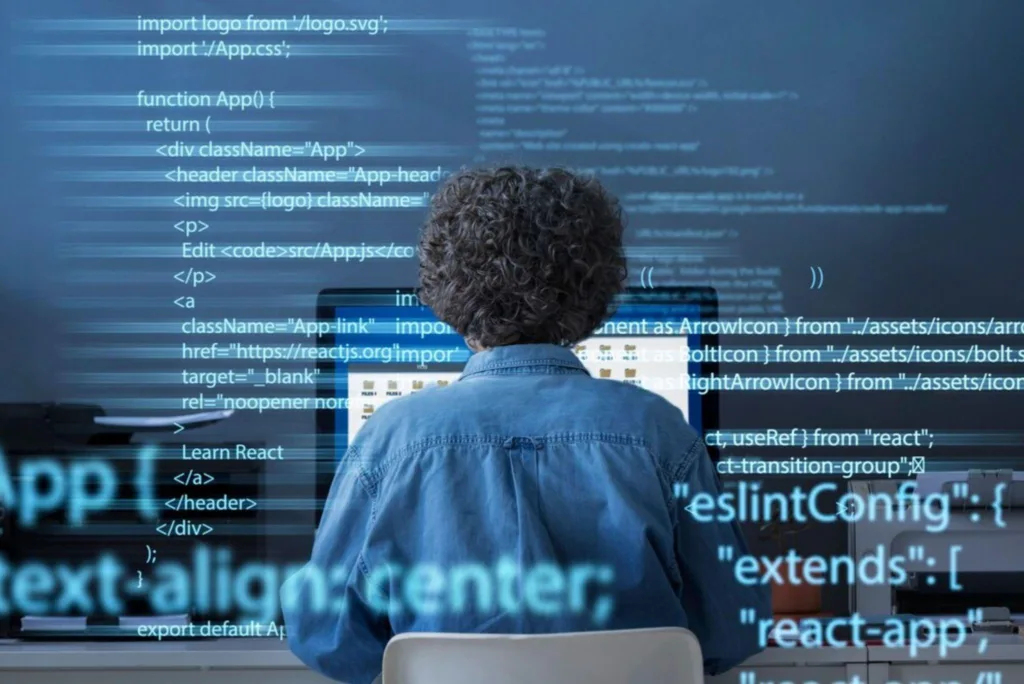
Before going into complex programs, it’s crucial for your child to grasp the fundamental building blocks of coding.
These are the basic ingredients that make up any code, and understanding them empowers kids to approach more challenging projects with confidence.
Let’s break down some key concepts;
1. Variables
Imagine these as containers that store information the program uses. Think of a box labeled “score” that holds a number representing the points your child has earned in a game. Variables can store different types of information, like numbers (integers, decimals), text (strings), or even true/false values (Booleans).
2. Data Types
This concept defines the kind of information a variable can store. Just like you wouldn’t put milk in a shoebox, data types ensure the information stored is compatible with how the program uses it.
For example, a variable meant to store a player’s name needs to be a string (text) type, while a variable for their lives remaining might be an integer (whole number) type.
3. Operators
These are like tools that perform operations on the data stored in variables. Think of basic math operations like addition, subtraction, multiplication, and division as examples. Operators can also compare information (greater than, less than, equal), combine text strings, or even check if a condition is true or false.
4. Control Flow
Coding isn’t just about displaying information; it’s about making decisions and controlling how the program behaves.
Control flow statements like “if,” “else,” and “loops” allow the program to change its course based on certain conditions or repeat specific actions multiple times.
This is a crucial concept for creating interactive experiences and building more complex programs.
Make use of Fun & Interactive Games
Learning shouldn’t feel like a chore! When it comes to coding for kids, incorporating engaging games can be a fantastic way to solidify understanding and keep them motivated.
Here are some fun and interactive games that introduce coding principles in a playful way;
- Coding Puzzles: These online games present your child with a challenge or scenario. They need to use logical thinking and apply their coding knowledge (often through drag-and-drop blocks) to solve the puzzle and achieve the desired outcome.
- Educational Apps: Many tablet and smartphone apps gamify the learning process. Kids can learn basic coding concepts like sequencing, loops, and problem-solving by completing levels, building virtual worlds, or even creating their own characters.
- Hour of Code Activities: Code.org offers a wide variety of free, one-hour coding activities themed around popular characters like Star Wars or Minecraft. These activities use block-based coding and are designed to be accessible for different age groups.
- Coding Challenges: Several online platforms host coding challenges specifically designed for kids. These challenges offer a fun and competitive environment where kids can apply their coding skills and learn from others.
The key is to choose games and activities that cater to your child’s interests and learning style.
Whether it’s solving logic puzzles, building their own virtual world, or competing with friends in a coding challenge, the joy of play will keep them engaged while strengthening their coding foundation.
Allow Your Kids Put Their Coding Skills Into Action
The beauty of coding lies in its potential to bring your child’s imagination to life! Now that they’ve grasped the basics and explored some fun games, it’s time to move on to creating their own projects.
Below are some engaging ideas that cater to different skill levels:
Beginner Projects
- Interactive Animations: Using platforms like Scratch, kids can design simple animations where characters move, change colors, or react to user input. This allows them to experiment with control flow and explore animation principles in a fun way.
- Guessing Games: These classic games are perfect for practicing conditional statements and loops. Kids can write code for a program that generates random numbers and provides hints to the player trying to guess the correct answer.
- Digital Storybooks: basic coding elements like animation and sound effects, kids can create interactive storybooks that come alive on the screen. This is a great way to combine their love for storytelling with their newfound coding skills.
Intermediate Projects
- Simple Games with Levels: Building upon the guessing game concept, kids can create games with multiple levels of difficulty. This requires them to utilize loops to keep track of score and difficulty progression.
- Interactive Music Players: By connecting code with sound libraries, kids can design programs that play different musical notes based on user input. This allows them to explore the relationship between coding and music creation.
- Text-Based Adventures: This classic format offers a unique way to practice decision-making logic. Kids can write code for a program that presents the player with choices throughout the story, altering the narrative based on their selections.
Advanced Projects
- Simple Simulations: Coding allows you to model real-world scenarios. Kids can create programs that simulate bouncing balls with physics principles, or portray simple ecosystems with interacting elements.
- Educational Apps for Others: Encouraging your child to share their knowledge is a fantastic way to solidify learning. With some guidance, they can create educational apps that teach basic coding concepts or other subjects to younger children.
- Customizable Games and Animations: As skills develop, kids can create games and animations that allow players to personalize elements like character appearances or game rules. This encourages creativity and problem-solving at a more advanced level.
Frequently Asked Questions
Let’s look at some frequently asked questions;
How do I start teaching my child to code?
Start teaching your child to code by introducing basic concepts through fun activities and games. Use kid-friendly coding tools and platforms, like Scratch, to make learning interactive.
Always encourage curiosity and provide guidance without being too directive. Celebrate their achievements to keep them motivated.
How do I teach my child to code online?
Teach your child to code online by exploring coding courses, tutorials, and platforms designed for kids. Supervise and engage with them as they navigate coding challenges. Encourage collaboration in online coding communities. Utilize educational apps and games to make learning fun and interactive.
Is coding good for kids?
Yes, coding is beneficial for kids as it fosters problem-solving, critical thinking, and creativity. It prepares them for the digital world and future career opportunities in technology. Coding boosts confidence and encourages a growth mindset.
What is the best programming language for a child to learn?
The best programming language for a child depends on their age and interests. Scratch is ideal for younger children with its visual blocks.
Python is versatile and widely used, suitable for beginners. JavaScript is great for older kids interested in web development.
Blockly offers a visual programming interface similar to Scratch. Choose a language that matches your child’s interests and encourages their curiosity.
Also Read: Java Coding For Kids 101
Final Thoughts
Having your kids equipped with coding skills is like giving them a superpower for the digital age. This journey starts with finding the right tools – age-appropriate platforms that make learning fun and engaging.
Now, don’t forget the foundational building blocks – variables, data types, and control flow – they’re the secret sauce to creating complex programs.
But most importantly, keep it playful! Let them experiment with games, puzzles, and challenges.
As they master the basics, encourage them to bring their imagination to life by building their own projects. Celebrate their achievements, big and small, and watch their confidence soar as they become creators in the digital world. Happy coding!


